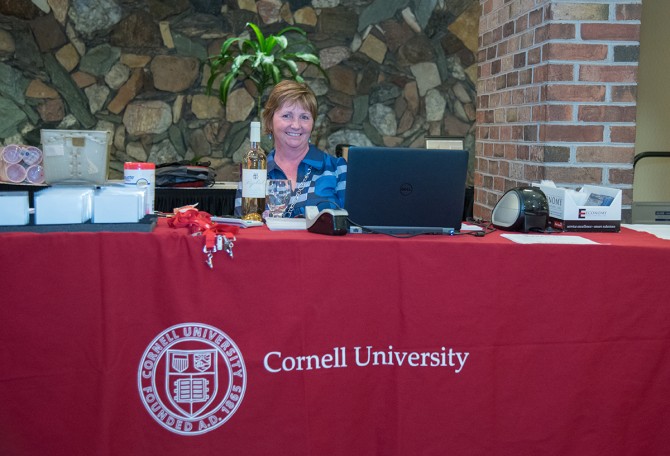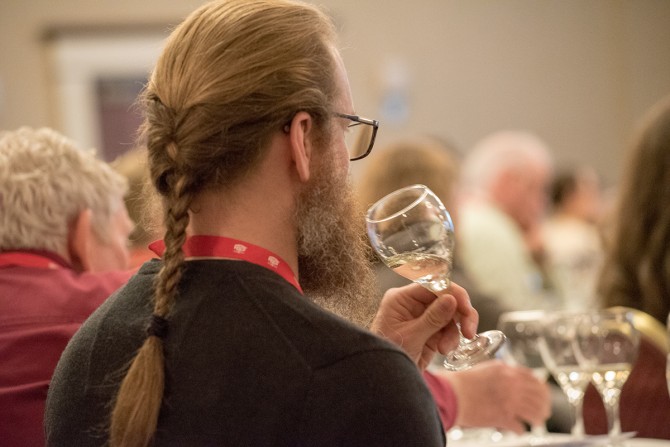
Anna Katharine Mansfield, associate professor of enology, and Hans Walter-Peterson and Chris Gerling, both extension associates, organized this week’s B.E.V. NY conference for the New York wine industry.
New York vintners urged to pop their corks at annual wine event
By Ben Rand
New York winemakers are proposing a toast to a new opportunity.
The state has the unique soil and climate conditions to establish itself as a significant market presence for a drink traditionally associated with celebrations, experts said at Cornell’s annual outreach event for the wine industry.
Just don’t slip and call it “champagne.” It’s “sparkling wine.”
More than 100 winemakers, grape growers, distributors, marketers, educators and others are attending the fifth annual B.E.V. NY conference and symposium, held Feb. 28 to March 2, organized jointly by the Cornell University Enology Extension Laboratory and the Finger Lakes Grape Program.
Attendees are getting practical advice and expert presentations on the wine business, as well as the art and science of enology and viticulture.
Sparkling wine would not only represent a new market, it would also command a higher, premium price, said Stephen Schmitz, account supervisor for Colangelo & Partners, a New York City marketing firm specializing in the beverage industry.
“It’s a new sweet spot,” Schmitz said. “New York is a cool-climate state, which works in favor of sparkling wines. That’s not just perception. It’s reality. You have the opportunity to produce more premium sparkling wine than many other regions.”
The opportunity is driven by changing tastes, said Anna Katharine Mansfield, associate professor of enology in the Department of Food Science at Cornell’s New York State Agricultural Experiment Station in Geneva, New York.
“Consumers in the United States are more and more interested in sparkling wines and we have lots of producers who are starting to make them across New York,” she said.
The climate helps to fuel the trend, said Hans Walter-Peterson, team leader and viticulture extension specialist with the Finger Lakes Grape Program of Cornell Cooperative Extension.
The cooler temperatures allow vineyards to grow grapes that are a “little fresher, with a little more acidity, which is exactly what you want in a sparkling wine,” he said. “We’re trying to get some information out there about not just the business and regulatory piece, but how to do it in the cellar and also what you can do to improve vineyard production.”
With the opportunity to produce sparkling wine, wineries in New York will face a learning curve, said Chris Gerling, extension associate and manager of the Vinification and Brewing Laboratory. The production of traditional-method sparkling wine requires a two-step process.
“Sparkling wine in particular is a very labor-intensive process, and sometimes people don’t understand that labor translating into the cost,” Gerling said. “So people aren’t necessarily willing to pay for all the work that goes into it.”
Attendees at B.E.V. NY heard updates on legislative and other issues from the presidents of the New York Wine & Grape Foundation and WineAmerica, which advocate for the wine industry statewide and nationally.
Practical advice also was offered on a range of business-related issues, such as marketing and social media. Representatives of three wineries – Meaghan Frank ’11, MPS ’15, of Dr. Konstantin Frank Vinifera Wine Cellars; Sarah Eighmey of Anthony Road Wine Co. and Miguel Martin of Palmer Vineyard – talked about redesigning their wine labels.
Brad Rickard, the Ruth and William Morgan Associate Professor in the Charles H. Dyson School of Applied Economics and Management, discussed his recent study looking at consumer acceptance of nontraditional (a.k.a., “fun”) wine labels. Rickard discovered that consumers perceived wines with less traditional labels to be of lower quality and value. However, “it did not affect their likelihood of purchasing the wine,” he said.
Ben Rand is media relations manager in the College of Agriculture and Life Sciences.
Media Contact
Get Cornell news delivered right to your inbox.
Subscribe


